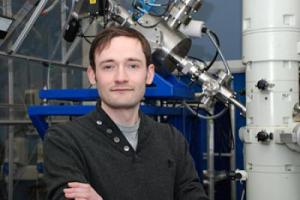Jan 7 2014
Manufacturers of increasingly minute computer chips, transistors and other products will have to take special note of research findings at the University of Huddersfield. The implications are that a key process used to transform the properties of nanoscale materials can cause much greater damage than previously realised.
 Manufacturers of increasingly minute computer chips, transistors and other products will have to take special note of research findings at the University of Huddersfield. The implications are that a key process used to transform the properties of nanoscale materials can cause much greater damage than previously realised. Pictured: Graeme Greaves. Credit: University of Huddersfield
Manufacturers of increasingly minute computer chips, transistors and other products will have to take special note of research findings at the University of Huddersfield. The implications are that a key process used to transform the properties of nanoscale materials can cause much greater damage than previously realised. Pictured: Graeme Greaves. Credit: University of Huddersfield
The University is home to the Electron Microscopy and Materials Analysis Research Group (EMMA), headed by Professor Stephen Donnelly. It has an advanced facility named MIAMI, which stands for Microscope and Ion Accelerators for Materials Investigation. It is used to bombard materials with ion beams and to examine the effects at the nanoscale.
During a recent experiment conducted by the team, including Research Fellow Dr Graeme Greaves, a number of gold nanorods – a thousand times smaller than a human hair – were irradiated with xenon atoms. They were a good subject for the experiment because nanowires or rods have a large surface area.
The findings were dramatic. "We were hoping to generate bubbles. We actually found that we were eroding the nanowires," said Dr Greaves.
And the rate of erosion – measured in terms of "sputtering yield", or how many atoms come out of matter for each incoming atom – was far in advance of expectations.
"The sputtering yield of a normal piece of flat gold should be of the order of 50 atoms per ion," said Dr Greaves. "In the case of rods we expected it to be greater, because the geometry is much reduced. We worked out that it should be higher by a factor of four, or something of that order. But we actually found that the greatest value measured was a sputtering yield of a thousand – a factor of 20."
The results were so dramatic that the Huddersfield team sought confirmation. They asked Professor Kai Nordlund(pictured right) of the University of Helsinki to run a molecular dynamics simulation, creating a virtual gold nanorod. The Finns were able to replicate the Huddersfield findings.
Now the experiment is the subject of an article in the leading journal Physical Letters Review, of Dr Greaves is the lead author.
"The research has considerable implications, particularly for medicine," said Dr Greaves. "More and more people are working on nanostructures for practical applications. Gold nanoparticles can be used for tumour detection, the optimisation of the bio-distribution of drugs to diseased organs and a radiotherapy dose enhancer.
"Components of computer chips are very small nowadays – in the order of 20 nanometres in size and getting smaller – and ion beams are used to change the properties of these materials. Our research shows you must be very wary of the amount of damage that may be done."
Source: http://www.hud.ac.uk/